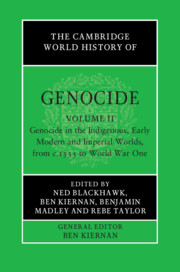Book contents
- The Cambridge World History of Genocide
- The Cambridge World History of Genocide
- The Cambridge World History of Genocide
- Copyright page
- Contents
- Figures
- Maps
- Tables
- Contributors to Volume ii
- Introduction to Volume ii
- Part I Settler Colonialism
- Part II Empire-Building and State Domination
- Part III Nineteenth-Century Frontier Genocides
- 15 The Genocidal French Conquest of Algeria, 1830–1847
- 16 ‘The Bloody Ground’
- 17 ‘A War of Extermination’
- 18 Lessons from Canada
- 19 Frontier Massacres in Australia, 1788–1928
- 20 Genocide in Van Diemen’s Land (Tasmania), 1803–1871
- 21 Genocide in Northern Australia, 1824–1928
- Part IV Premonitions
- Index
18 - Lessons from Canada
The Question of Genocide in US Boarding Schools for Native Americans
from Part III - Nineteenth-Century Frontier Genocides
Published online by Cambridge University Press: 23 June 2023
- The Cambridge World History of Genocide
- The Cambridge World History of Genocide
- The Cambridge World History of Genocide
- Copyright page
- Contents
- Figures
- Maps
- Tables
- Contributors to Volume ii
- Introduction to Volume ii
- Part I Settler Colonialism
- Part II Empire-Building and State Domination
- Part III Nineteenth-Century Frontier Genocides
- 15 The Genocidal French Conquest of Algeria, 1830–1847
- 16 ‘The Bloody Ground’
- 17 ‘A War of Extermination’
- 18 Lessons from Canada
- 19 Frontier Massacres in Australia, 1788–1928
- 20 Genocide in Van Diemen’s Land (Tasmania), 1803–1871
- 21 Genocide in Northern Australia, 1824–1928
- Part IV Premonitions
- Index
Summary
In 2015, the Truth and Reconciliation Commission of Canada (TRC) concluded that Canada had committed “cultural genocide” in government-supported residential schools that aimed to forcibly assimilate First Nations peoples since the nineteenth century. The TRC’s finding of cultural genocide in Canada can inform our understanding of American Indian boarding schools in the U.S. given the similarities and connections between the two systems. Both countries founded their schools with the aim of achieving total assimilation, or cultural genocide. Both, however, did much more than forcibly assimilate Indigenous youth. At the root of U.S. and Canadian Indigenous education project rests a genocidal truth: they may have committed all of the genocidal crimes enumerated in the UNGC. School administrators held people year after year with full knowledge of how lethal the schools were and an explicit plan to commit cultural genocide. This chapter demonstrates how scholars of the American Indian boarding schools can learn from the TRC, consider how we may evaluate the schools under the UNGC, and ultimately conduct additional data-gathering in order to reach a better understanding of what happened in these institutions.
Keywords
- Type
- Chapter
- Information
- The Cambridge World History of Genocide , pp. 434 - 460Publisher: Cambridge University PressPrint publication year: 2023

